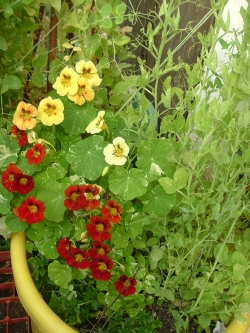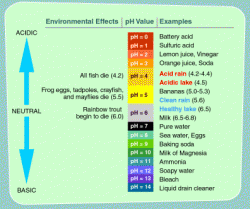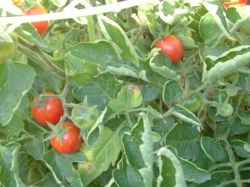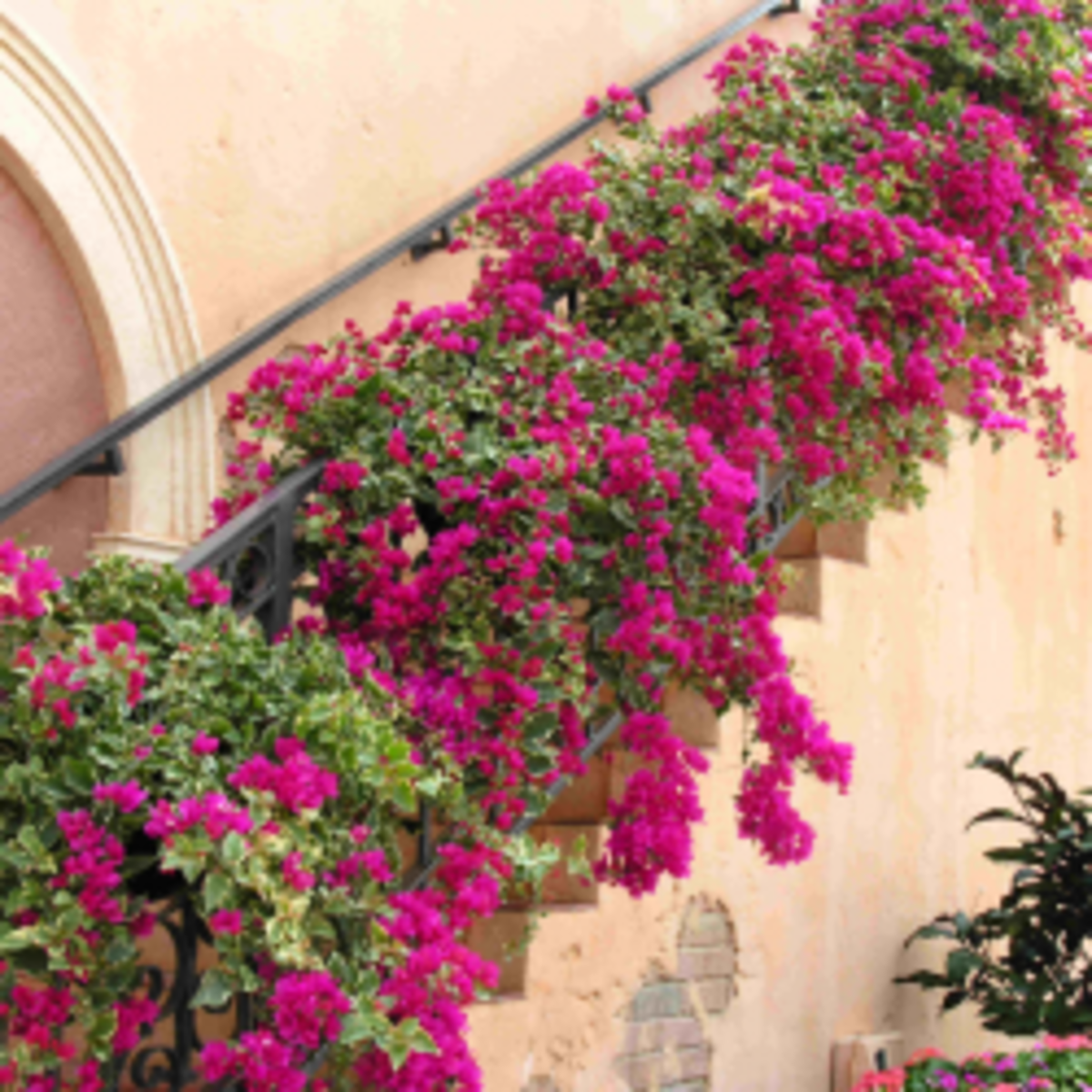What is pH?

The simple explanation
A simple explanation of what is pH, also called the soil reaction and why it is important to your gardening efforts. I have also added some information to help you raise or lower the pH of your garden soil.

Exactly what does pH stand for?
You might remember the pH scale from high school science class (or then again, maybe not!) pH is simply a measure of how acid or alkaline a substance is. The scale goes from 0 to 14. A pH of 7 means that the substance is neutral, neither acid nor alkaline. Ratings less than 7 are acid and those higher than 7 are alkaline (also called 'base' in chemistry)
The difference between each number on the scale is 100 times more or less than the number above or below it. In other words 2 is one hundred times more acid than 3 and 9 is one hundred more times alkaline than 8.

Why pH Matters in your Garden
In our gardens we grow many different sorts of plants, which evolved in radically different places all over the world. A tropical rainforest or other area which receives a lot of rain (Ireland, England and a lot of Europe also) will have soil and water that are on the acid side of the scale. A dry, desert like environment will have soil and water which is highly alkaline.
Some of the minerals and nutrients that plants need for good growth become 'tied up' or less available at different pH levels. Plants that have evolved in an area with a specific soil pH will be used to having certain nutrients abundantly available to them. Sometimes these are listed in gardening books as 'needing' more of a specific nutrient. When we try to grow these plants in soil that is very different, when that nutrient is 'tied up' or less available, some plants will show signs of deficiency of the nutrient, they grow poorly, if at all. Sometimes they just shrivel up and die.
For most plants a soil reaction of 6.5 to 7.5 will give a good availability of all nutrients. Some individual species may do well at a higher or lower pH than other related species.
In general you should have your soil tested for the major nutrients of nitrogen (N), phosphorous (P) and potash (K) and it's pH, annually. For the home gardener there are simple home test kits, some of which will give you a lot of information. For the serious gardener, market gardener or small farmer, a detailed analysis from a soil testing laboratory is in order.
The Rapitest are commonly available at big box garden centers as well as online. Reasonably accurate they can give you a quick idea of what your soil is like.

By testing your soil pH you will have an idea of where your soil stands now and it may give you clues if your plants have not been doing as well as you'd hoped. I garden in the desert and our soils are highly alkaline. This tie's up iron and nitrogen, two nutrients that work hand in hand to make the chlorophyll in green plants. When I first started gardening here many plants were sickly yellow and died an early death. I've used many different things to lower the pH of the soil and to add available iron and nitrogen so that now most of my plants are green and healthy.
A website that I have found extremely helpful in identifying nutrient deficiencies is Color Pictures of Mineral Deficiencies in Plants

HOW TO RAISE SOIL pH.
Lucky for you if you live in the eastern part of the United States or an other area where the soil pH is on the acid side of the scale. It is much easier and less expensive to raise pH than it is to lower it.
To raise the pH of your garden soil it is easy to sprinkle on some ground agricultural limestone. This is lime specially prepared for gardening use and should be readily available at any garden or farm supply center in areas where it is needed. It is always a good idea to only add a little at a time, re-testing 2-3 months later and adding more if necessary. This is because it is easy to over lime the soil and make it too alkaline and because it takes a little time for the lime to become effective in the soil. Spread the lime as evenly as you can and lightly dig it in, watering well afterwards. Wait a couple of weeks after liming before planting. Actually the best time to lime is probably in the fall, leaving the garden fallow over the winter.
Most authorities will not give a standard amount of lime to add to soil since the amount varies depending on the soil type. Heavy clay soil will take two to three times the amount needed by a sandy soil of the same pH. I did find an article from a UK gardening site, (Which? Gardening, http://www.which.co.uk) and have converted the measurements they gave into pounds per 100 square feet of garden space.
These amounts are the amount of ground agricultural lime to add to 100 square feet to raise the pH to 7.5
If your soil pH is 6 and your soil type is clay, add 9 pounds
If your soil pH is 6 and your soil type is loam, add 5 1/2 pounds
If your soil pH is 6 and your soil type is sandy, add 2 3/4 pounds
If your soil pH is 5 and your soil type is clay, add 25 pounds
If your soil pH is 5 and your soil type is loam, add 16 1/2 pounds
If your soil pH is 5 and your soil type is sandy, add 10 pounds
Wood ash can also be used to raise the soil pH and has an advantage of containing significant amounts of calcium and potash along with small amounts of many trace elements. Calculating the rate of application is tricky. This is because wood ash contains more of certain nutrients than lime and also has a higher pH than lime (10.4 compared to 9.9 for lime). Using too much wood ash (like any other material) could cause a toxic build up of minerals. However you could certainly use wood ash to substitute for a part of the recommend amount of lime. I would err on the side of caution and use less wood ash than the recommended amount of lime, then retest in a few months and make adjustments then.

TO LOWER SOIL pH
If you live in an area where the soil is extremely alkaline then you will need to be constantly working to lower the pH of your garden soil. This is because generally if the soil is alkaline then so is the water that you are using. Constantly adding alkaline water to the garden negates the acidic properties of the material you add to the soil. The best you can hope for is to move the soil pH towards neutral the best you can, however you will probably never get it all the way down to pH 7 if your soil starts out at 8.5.
The best thing to do for alkaline soils is to add as much organic matter as you possibly can. Organic matter also has other benefits, it helps to absorb and hold water in the soil, it helps break up the heavy caliche clay and it does buffer the pH to some extent. One caveat, if you are trying to lower the pH of your garden soil, do not use that soil in your compost pile or your compost will also have a high pH.
If you are only working on a small area, then adding some peat moss can be helpful. While it doesn't really have a lot of nutritional value, it is highly acidic and will lower the pH of the soil and the effects will carry over into the next growing season. I try to buy peat moss in large bales when it is on sale at the garden center.
Another soil additive for lowering pH is soil sulfur. I worked out the following from my copy of the Western Fertilizer Handbook, copyright 1990.
The approximate amount of 95% pure Soil Sulfur to increase the acidity of soil 6 inches deep on a carbonate free soil. These are the amounts to use on 100 square feet to lower the pH to 6.5
If the soil pH is 8.5 and the soil type is clay use 6.8 pounds.
If the soil pH is 8.5 and the soil type is loam use 5.7 pounds.
If the soil pH is 8.5 and the soil type is sandy use 4.5 pounds.
If the soil pH is 8 and the soil type is clay use 4.6 pounds.
If the soil pH is 8 and the soil type is loam use 3.4 pounds.
If the soil pH is 8 and the soil type is sandy use2.75 pounds.
When applying soil sulfur it should be worked into the top six inches of the soil and watered in. It takes some time for the bacteria in the soil to break down the sulfur into sulfuric acid, which is what lowers the pH. I would advise first doing any digging of the area and adding as much organic matter and peat moss as possible. Keep the area watered for a few days to get the soil bacteria working well, then add the sulfur. Wait a couple of weeks before planting, perhaps a month if you are using the large amounts listed above. Retest the soil in 3 months and make another application, adjusting the amount applied depending on how much lower the pH is now.
Another thing that can help lower soil pH over time is to keep an acidic mulch on top of the growing area. Cottonseed hulls, pine needles, pine tree bark and sawdust are all acidic and can help keep the pH lower as they break down into the soil.
And if you are bound and determined to grow acid loving plants like azaleas, gardenias, blue berries and such, the best thing you can do is plant them in pots. Use a peat based potting soil and water them with rain water, or if you must use tap water, add about 1 teaspoon of vinegar per gallon to help lower the pH. Let it stand overnight before watering.
Was this information helpful to you? Is there something else I could add that would make it even better? (I do intend to write a more scientific explanation of the soil reaction and how soils at the extreme acid and alkaline ends tie up different nutrients.
© 2011 hysongdesigns




